SUBARU LEGACY 2016 6.G User Guide
Manufacturer: SUBARU, Model Year: 2016, Model line: LEGACY, Model: SUBARU LEGACY 2016 6.GPages: 572
Page 11 of 572
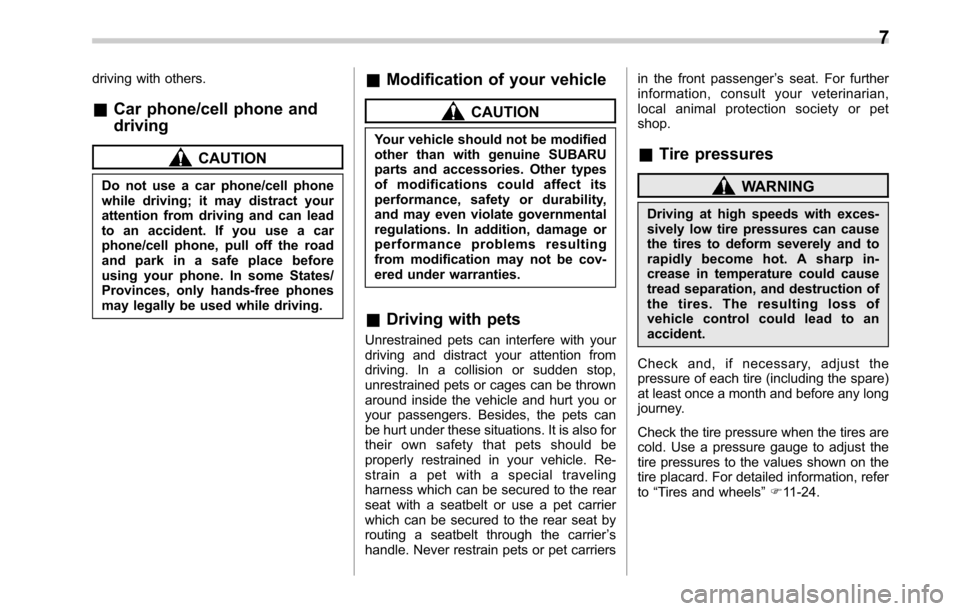
driving with others.
&Car phone/cell phone and
driving
CAUTION
Do not use a car phone/cell phone
while driving; it may distract your
attention from driving and can lead
to an accident. If you use a car
phone/cell phone, pull off the road
and park in a safe place before
using your phone. In some States/
Provinces, only hands-free phones
may legally be used while driving.
&Modification of your vehicle
CAUTION
Your vehicle should not be modified
other than with genuine SUBARU
parts and accessories. Other types
of modifications could affect its
performance, safety or durability,
and may even violate governmental
regulations. In addition, damage or
performance problems resulting
from modification may not be cov-
ered under warranties.
&Driving with pets
Unrestrained pets can interfere with your
driving and distract your attention from
driving. In a collision or sudden stop,
unrestrained pets or cages can be thrown
around inside the vehicle and hurt you or
your passengers. Besides, the pets can
be hurt under these situations. It is also for
their own safety that pets should be
properly restrained in your vehicle. Re-
strain a pet with a special traveling
harness which can be secured to the rear
seat with a seatbelt or use a pet carrier
which can be secured to the rear seat by
routing a seatbelt through the carrier’s
handle. Never restrain pets or pet carriersin the front passenger’s seat. For further
information, consultyour veterinarian,
local animal protection society or pet
shop.
&Tire pressures
WARNING
Driving at high speeds with exces-
sively low tire pressures can cause
the tires to deform severely and to
rapidly become hot. A sharp in-
crease in temperature could cause
tread separation, and destruction of
the tires. The resulting loss of
vehicle control could lead to an
accident.
Check and, if necessary, adjust the
pressure of each tire (including the spare)
at least once a month and before any long
journey.
Check the tire pressure when the tires are
cold. Use a pressure gauge to adjust the
tire pressures to the values shown on the
tire placard. For detailed information, refer
to“Tires and wheels”F11-24.
7
Page 12 of 572
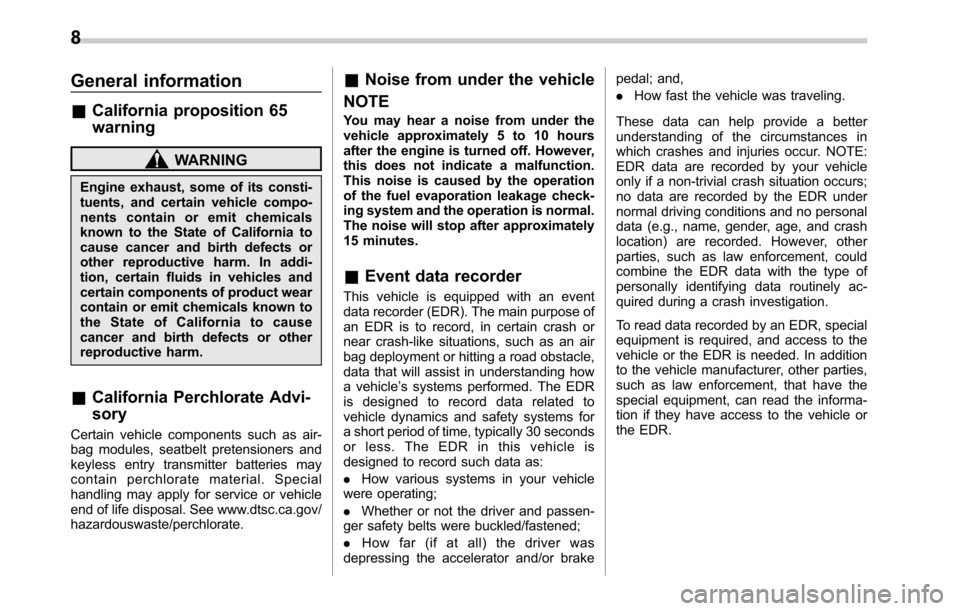
General information
&California proposition 65
warning
WARNING
Engine exhaust, some of its consti-
tuents, and certain vehicle compo-
nents contain or emit chemicals
known to the State of California to
cause cancer and birth defects or
other reproductive harm. In addi-
tion, certain fluids in vehicles and
certain components of product wear
contain or emit chemicals known to
the State of California to cause
cancer and birth defects or other
reproductive harm.
&California Perchlorate Advi-
sory
Certain vehicle components such as air-
bag modules, seatbelt pretensioners and
keyless entry transmitter batteries may
contain perchlorate material. Special
handling may apply for service or vehicle
end of life disposal. See www.dtsc.ca.gov/
hazardouswaste/perchlorate.
&Noise from under the vehicle
NOTE
You may hear a noise from under the
vehicle approximately 5 to 10 hours
after the engine is turned off. However,
this does not indicate a malfunction.
This noise is caused by the operation
of the fuel evaporation leakage check-
ing system and the operation is normal.
The noise will stop after approximately
15 minutes.
&Event data recorder
This vehicle is equipped with an event
data recorder (EDR). The main purpose of
an EDR is to record, in certain crash or
near crash-like situations, such as an air
bag deployment or hitting a road obstacle,
data that will assist in understanding how
a vehicle’s systems performed. The EDR
is designed to record data related to
vehicle dynamics and safety systems for
a short period of time, typically 30 seconds
or less. The EDR in this vehicle is
designed to record such data as:
.How various systems in your vehicle
were operating;
.Whether or not the driver and passen-
ger safety belts were buckled/fastened;
.How far (if at all) the driver was
depressing the accelerator and/or brakepedal; and,
.How fast the vehicle was traveling.
These data can help provide a better
understanding of the circumstances in
which crashes and injuries occur. NOTE:
EDR data are recorded by your vehicle
only if a non-trivial crash situation occurs;
no data are recorded by the EDR under
normal driving conditions and no personal
data (e.g., name, gender, age, and crash
location) are recorded. However, other
parties, such as law enforcement, could
combine the EDR data with the type of
personally identifying data routinely ac-
quired during a crash investigation.
To read data recorded by an EDR, special
equipment is required, and access to the
vehicle or the EDR is needed. In addition
to the vehicle manufacturer, other parties,
such as law enforcement, that have the
special equipment, can read the informa-
tion if they have access to the vehicle or
the EDR.
8
Page 13 of 572

Table of contents
Seat, seatbelt and SRS airbags1
Keys and doors2
Instruments and controls
Climate control4
Audio5
Interior equipment6
Starting and operating7
Driving tips8
In case of emergency9
Appearance care10
Maintenance and service11
Specifications12
Consumer information and Reporting safety defects13
Index14
3
Page 14 of 572
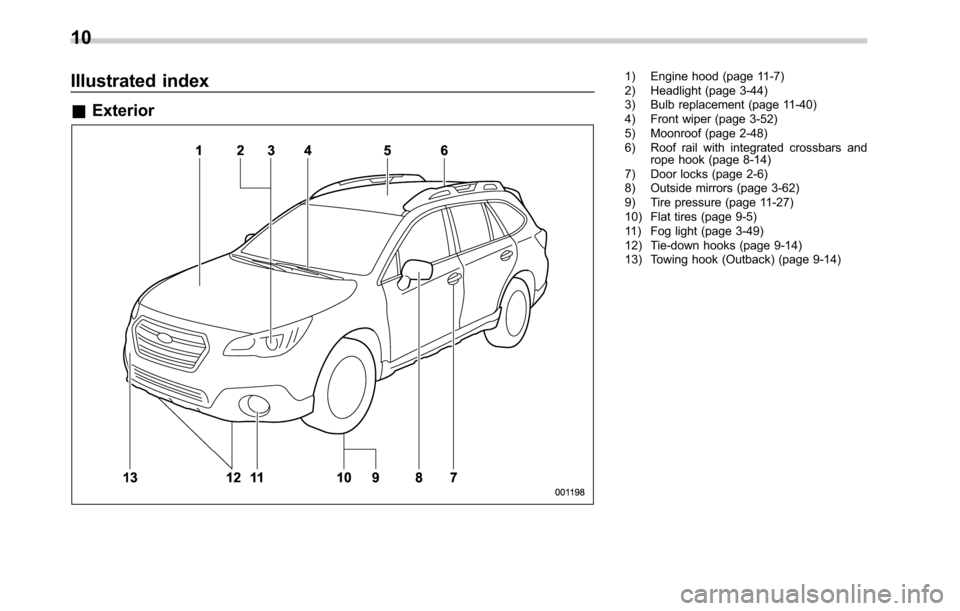
Illustrated index
&Exterior
1) Engine hood (page 11-7)
2) Headlight (page 3-44)
3) Bulb replacement (page 11-40)
4) Front wiper (page 3-52)
5) Moonroof (page 2-48)
6) Roof rail with integrated crossbars and
rope hook (page 8-14)
7) Door locks (page 2-6)
8) Outside mirrors (page 3-62)
9) Tire pressure (page 11-27)
10) Flat tires (page 9-5)
11) Fog light (page 3-49)
12) Tie-down hooks (page 9-14)
13) Towing hook (Outback) (page 9-14)
10
Page 15 of 572

1) Rear window defogger (page 3-54)
2) Fuel filler lid and cap (page 7-4)
3) Child safety locks (page 2-33)
4) Towing hook (page 9-14)
5) Trunk lid (page 2-38)
6) Rear wiper (page 3-53)
7) Rear gate (page 2-40)
8) Bulb replacement (page 11-43)
9) Tie-down holes (page 9-14)
–CONTINUED–
11
Page 16 of 572

&Interior
!Passenger compartment area
1) Lower anchorages for child restraint
system (page 1-35)
2) Seatbelt (page 1-16)
3) Center console (page 6-6)
4) Front seat (page 1-2)
5) Rear seat (page 1-11)
12
Page 17 of 572
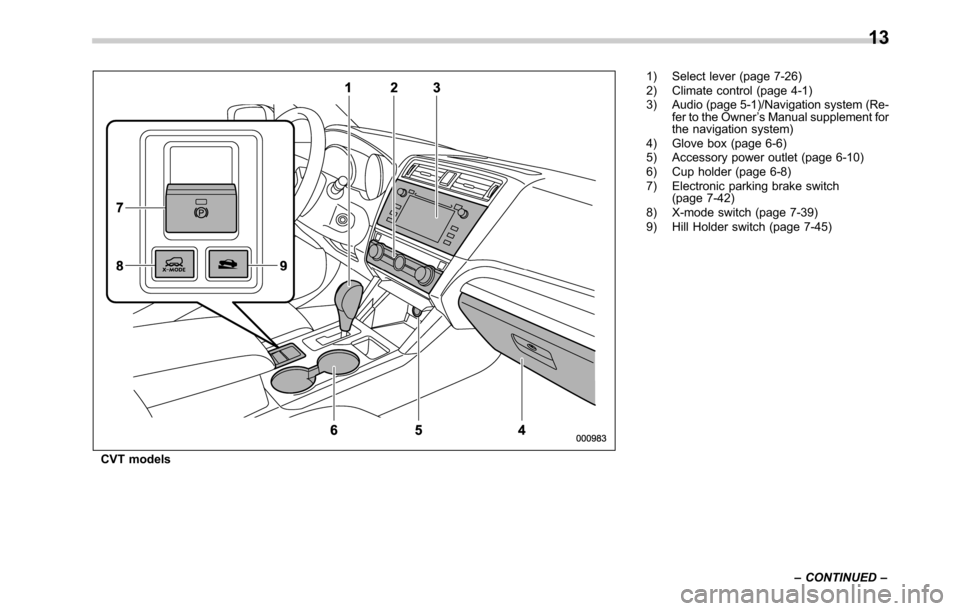
CVT models1) Select lever (page 7-26)
2) Climate control (page 4-1)
3) Audio (page 5-1)/Navigation system (Re-
fer to the Owner’s Manual supplement for
the navigation system)
4) Glove box (page 6-6)
5) Accessory power outlet (page 6-10)
6) Cup holder (page 6-8)
7) Electronic parking brake switch
(page 7-42)
8) X-mode switch (page 7-39)
9) Hill Holder switch (page 7-45)
–CONTINUED–
13
Page 18 of 572

MT models1) Shift lever (page 7-23)
2) Climate control (page 4-1)
3) Audio (page 5-1)/Navigation system (Re-
fer to the Owner’s Manual supplement for
the navigation system)
4) Glove box (page 6-6)
5) Accessory power outlet (page 6-10)
6) Cup holder (page 6-8)
7) Electronic parking brake switch
(page 7-42)
8) Hill Holder switch (page 7-45)
14
Page 19 of 572
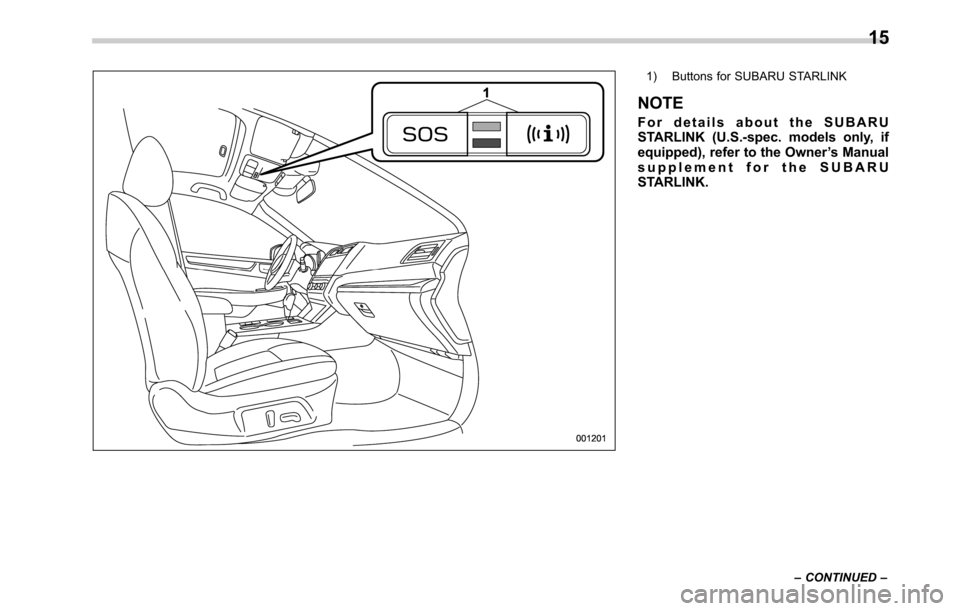
1) Buttons for SUBARU STARLINK
NOTE
For details about the SUBARU
STARLINK (U.S.-spec. models only, if
equipped), refer to the Owner’s Manual
supplement for the SUBARU
STARLINK.
–CONTINUED–
15
Page 20 of 572
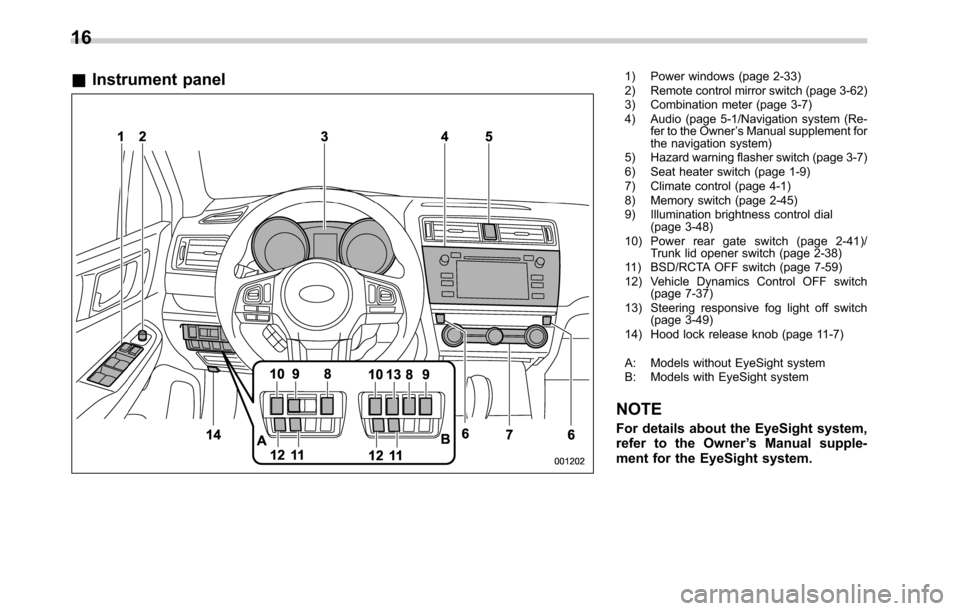
&Instrument panel1) Power windows (page 2-33)
2) Remote control mirror switch (page 3-62)
3) Combination meter (page 3-7)
4) Audio (page 5-1/Navigation system (Re-
fer to the Owner’s Manual supplement for
the navigation system)
5) Hazard warning flasher switch (page 3-7)
6) Seat heater switch (page 1-9)
7) Climate control (page 4-1)
8) Memory switch (page 2-45)
9) Illumination brightness control dial
(page 3-48)
10) Power rear gate switch (page 2-41)/
Trunk lid opener switch (page 2-38)
11) BSD/RCTA OFF switch (page 7-59)
12) Vehicle Dynamics Control OFF switch
(page 7-37)
13) Steering responsive fog light off switch
(page 3-49)
14) Hood lock release knob (page 11-7)
A: Models without EyeSight system
B: Models with EyeSight system
NOTE
For details about the EyeSight system,
refer to the Owner’s Manual supple-
ment for the EyeSight system.
16